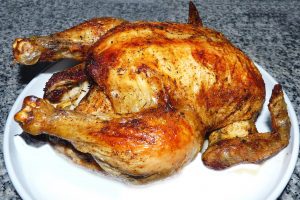3.2 Vocabulary and Grammar: Using Present Tense with Food Vocabulary
In this section:
- You will learn new vocabulary on food and drinks.
- You will study and practice the use of verbs in the present tense.
Vocabulary (1)
Listen and read through the following words and expressions.
| English | Transcription | Arabic | English | Transcription | Arabic |
|---|---|---|---|---|---|
| I have | 'indi | عندي | chicken | dajaaj | دجاج |
| I do not have | laysa 'indi | ليس عندي | meat | laHm | لحم |
| he has | 'indahu | عنده | salad | SaLaTah | سلطة |
| he does not have | laysa 'indahu | ليس عنده | bread | Khubz | خُبز |
| she has | 'indaha | عندها | milk | Haleeb | حليب |
| she does not have | laysa 'indaha | ليس عندها | sugar | sukkar | سُكّر |
| there is/are | hunaak | هناك | tea | Shay | شاي |
| there is not/ are not | laysa hunaak | ليس هناك | coffee | qahwa | قهوة |
| this is (m.) | haatha | هذا | water | maa' | ماء |
| this is (f.) | haathi-hi | هذه | juice | 'aSeer | عصير |
| what? | maatha | ماذا | I drink | ashrab | أشرب |
| how? | kaifa | كيف | I eat | aakul | آكل |
| is/are/do/does? | hal | هل | I like | أحب | |
| morning | SaBaaH | صباح | I do not like | UHibb | لا أحب |
| evening | masaa' | مساء | I want | uriid | أريد |
| every day | kul yawm | كل يوم | I do not want | La uriid | لا أريد |
| news | akhbaar | أخبار | I study | adrus | أدرس |
| bus | utubiis | أوتوبيس | I watch | ushahid | أشاهد |
| bike | darrajah | درّاجة | I go to | ath-hab ila | أذهب إلى |
Grammar (1)
Present Tense Verbs
Learn the verb conjugations in the present tense.
| to drink | to eat | to study | to love | pronoun |
|---|---|---|---|---|
| أشرب ashrab |
آكل aakul |
أدرس adrus |
أحِب uHibb |
أنا ana |
| تشرب tashrab |
تأكل taakul |
تدرس tadrus |
تُحِب tuHibb |
أنتَ anta |
| تشربين tashrabiin |
تأكلين taakuliin |
تدرسين tadrusiin |
تٌحبين tuHibbin |
أنتِ anti |
| يشرب yashrab |
يأكل yaakul |
يدرس yadrus |
يُحب yuHibb |
هو huwa |
| تشرب tashrab |
تأكل taakul |
تدرس tadrus |
تُحب tuHibb |
هي heya |
Notes on Grammar
- There is no indefinite article in Arabic. There is also no (am-is-are). The definite article “the” is expressed by attaching “Al” in the beginning of the noun. For example: Kitaab means “a book”, and Alkitaab means “the book”.
- Verbs in the present tense follow predictable forms that we will discuss in the grammar section.
- Some verbs take certain propositions. One of these is the verb أذهب “AthHab” which must be followed by the proposition إلى “ilaa,” so أذهب إلى means “go to”. Another example is أسكن which should be followed by the proposition في “fee”.
- When you use two verbs side-by-side, they should be split by the infinitive “to” (ann) أن . An example is a sentence like أريد أن أشرب (urid ann ashrab) “I want to drink,” or أحب أن أشاهد التليفزيون (uHibb ann ushahid al telefizyon“I like to watch TV.”
- The question word (hal) is used to initiate yes/no questions.
- If you start a sentence with a verb, you will have جملة فعلية , a verbal sentence. If you start with a noun, you will have جملة إسمية , a nominal sentence.
- Note that a phrase starting with عند is not a verb, but rather a propositional phrase and it is considered a nominal sentence when you say عندي سيارة “I have a car”. The same applies to the هناك there is/are phrases, which count as nominal sentences too.
- The verbal sentence is negated with لا, while the nominal sentence is negated with ليس.
Activity (5): Complete the conjugations of the following verbs, guided by the given examples in each slide.
Activity (6): With the teacher and then with the classmates, ask and answer the following questions, then report to class.
| مع زميلة | مع زميل |
|---|---|
| ماذا تحبين أن تشربي؟ Maatha tuHibbin an tashrabi fi alSaBaaH? |
ماذا تحب أن تشرب في الصباح؟ Maatha tuHibb an tashrab fi alSaBaaH? |
| ماذا تحبين أن تأكلي؟ maatha tuHibbin an taakuli? |
ماذا تحب أن تأكل؟ maatha tuHibb an taakul? |
| أين تسكنين؟ ayna taskuniin |
أين تسكن؟ ayna taskun? |
| كيف تذهبين إلى الجامعة؟ kaifa tathHabiin ila al jami'aa? |
كيف تذهب إلى الجامعة؟ kaifa tathHab ila al Jami'aa? |
Activity (7): Create basic sentences (either nominal or verbal) using the image clues below. Write your sentences in the box below.
 |
 |
| __________________________ | __________________________ |
 |
 |
| __________________________ | __________________________________ |
 |
 |
| __________________________ | __________________________________ |
 |
 |
| __________________________ | _____________________________ |
Key Takeaways
- There is a distinction between nominal and verbal sentences in Arabic based on how you start the sentence.
- Verbs in the present tense are formed by the use of prefixes that denote different pronouns.

